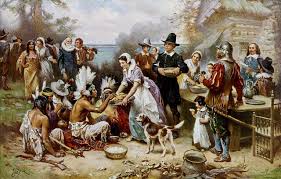Happy Thanksgiving to all our US visitors, I hope you have a great day tomorrow with your friends and family. In the UK and the rest of Europe we don’t have Thanksgiving, although my church in the UK did have a harvest festival service, and all I knew about Thanksgiving was that it was something to do with the Pilgrim Fathers and that people eat turkey and pumpkin pie. So, I decided to do a bit of digging and here is what I found. Please forgive me if I get anything wrong – just blame wikipedia and the History Channel!!

Please can you comment on this post to tell me how you celebrate Thanksgiving. Do you have any special family traditions? I’d love to know. I’m going to have to wait until Christmas for my turkey and I’ve never tasted pumpkin pie – very sad.
The First Thanksgiving
There seems to be a bit of an argument about who exactly celebrated the very first Thanksgiving and when it was celebrated, but the “acknowledged” first Thanksgiving was the harvest feast which was shared between the Wampanoag Indians and the Plymouth colonists in 1621. This harvest meal was actually nothing new for the Native Americans who had always given thanks and celebrated their harvest long before any Europeans arrived, but this first Thanksgiving symbolised the relationship of cooperation which had grown between the English colonists and Native Americans.
Another example of a thanksgiving ceremony involving the European settlers is the very first recorded ceremony of thanksgiving in December 1619 when a group of British settlers prayed and gave thanks to the Lord for their safe arrival. Whichever date you take as the First Thanksgiving, Thanksgiving is the same, it is a time to give thanks for harvest, the food that we have and all the blessings that God gives us. It is also a time to spend with family and friends, something that can be hard to do with our busy lives.
The Thanksgiving Meal
As I was pretty clueless about Thanksgiving dinner, I asked Daniela, our jeweller, what her family eat at Thanksgiving and she came up with turkey, stuffing, cranberry sauce, sweet potatoes, green beans, corn, mashed potatoes and casseroles, followed by pumpkin pie or apple pie – yum! It sounds pretty similar to the British Christmas dinner, but it is very different to the meal that would have been enjoyed at the very first Thanksgiving which definitely would not have included cranberry sauce or pumpkin pie. Although we do not know exactly what was eaten in 1621, according to the History Channel historians do know that wildfowl (nearly turkey!) and venison were on the menu as both have been mentioned in primary sources.
In “A Journal of the Pilgrims at Plymouth” from 1621, Edward Winslow wrote:-
“Our harvest being gotten in, our governor sent four men on fowling, that so we might after a special manner rejoice together after we had gathered the fruit of our labors. They four in one day killed as much fowl as, with a little help beside, served the company almost a week. At which time, among other recreations, we exercised our arms, many of the Indians coming amongst us, and among the rest their greatest king Massasoit, with some ninety men, whom for three days we entertained and feasted, and they went out and killed five deer, which they brought to the plantation and bestowed upon our governor, and upon the captain, and others. And although it be not always so plentiful as it was at this time with us, yet by the goodness of God, we are so far from want that we often wish you partakers of our plenty.”
According to the trusty History Channel, foods that would have appeared on the pilgrim’s menu include:-
- Wild fowl – Swan, goose, duck, partridge, wild turkey, eagle and crane
- Seafood – Lobster, cod, clams and eel
- Fruit – Grapes and plums
- Meat – Venison and seal
- Vegetables – Pumpkin, carrots, onions, beans, peas, radishes and lettuce
- Grain – Indian corn and wheat flour
- Nuts – Acorns, Chestnuts and walnuts
- Herbs and seasoning – Currants, parsnips, liverwort, leeks and olive oil
The meal would have been a selection of meats, as opposed to the modern Thanksgiving meal of turkey, vegetables and other side dishes. This was because there wasn’t a huge choice of vegetables available for the pilgrims and their active diet meant that their bodies could handle this more fatty diet which was also high in much needed protein. Pumpkin, if available, would have been boiled, rather than made into a pie, because the pilgrims did not have ovens.
Of course, the pilgrims didn’t sit down a festive table with the best plates and cutlery, they would have eaten with their fingers, spoons and knives, not forks. Food would have been put on the table and the pilgrims would have helped themselves from the food nearest to them and this food would also not have been served in course but served all at the same time, although puddings may have been served separately. People who were important in rank would have the best food placed near them.
So, that is a very brief rundown of the First Thanksgiving, now it’s your turn to tell me about how you celebrate Thanksgiving – come on, educate me!
Happy Thanksgiving!